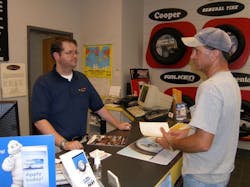This MTD exclusive was provided by Dennis McCarron, author of MTD's monthly Business Insights column and a partner at Cardinal Brokers, one of the leading brokers in the tire and automotive industry (www.cardinalbrokers.com).
Imagine hanging out in the waiting area of a typical tire dealership and observing the ebb and flow of customers, along with the routines of its employees.
Some customers are organized and prepared. (Maybe they even had appointments?) Some are caught off-guard with unexpected life disruptors, like a flat tire on the way to work. Still other customers wander in - oblivious to the volume - and ask if they can wait for an engine diagnostic because “the light just came on and I’m going on vacation.”
We also have employees to watch. They struggle to keep to a process, whether it’s a company rule or self-taught. There are customers waiting patiently in line to be serviced. Then the phone rings. Multiple lines light up. There’s a service technician loitering on the back side of the counter, wondering aloud where their parts are that were ordered an hour ago.
Just a typical day at the shop!
This scenario plays out all day long in thousands of tire dealerships across America. The pressure on counter staff and salespeople is heavy.
Under that duress, many employees develop internal rules to manage or mitigate the pressure, such as only one walk-in oil change per hour, flats are drop-off only and service work after 3 pm.
Sometimes these rules rile customers who find themselves not fitting into the mold of how the dealership handles the variety of tire and service problems thrown at it on a daily basis.
If you are a reputation-based business - in other words, a business that has a loyal following and has been around the neighborhood for a number of years - I’m going to let you in on a little secret.
You don’t need to bend over backwards for every little job that comes through the front door. However, there are a few things you do need to do.
First let’s assess the situation. Are you constantly struggling to handle the volume of flat repairs all day long or is it a spotty problem here and there? If it’s a constant stream, you have to figure out why. Are you the cheapest flat repair in town? Raising your prices will control some volume. Or maybe everyone in town knows that you will drop everything you’re doing, including that $700 brake job, to pull in a flat repair “right now” because some customer is in a hurry?
Secondly, you have to start doing what’s right for your business and balance that with the needs of the customer. Remember, the flat repair is an emergency for the customer because it’s unexpected. They want the problem to go away so they are going to be forceful in communicating that urgency.
It is up to your salespeople to recognize that urgency and react professionally. That means offering empathy and options, which leads to my next piece of advice.
You need to create additional options for the customer that they can’t see or understand yet. Tell the customer, “I understand how frustrating getting a flat first thing in the morning is.” Then provide the customer with his or her options. Say, “I can quickly put your spare on so you can get to work on time and will text you later when we find out what’s wrong with the tire.” Or you can say, “You mentioned you’ve noticed a slow leak. Let’s put some air in it now and schedule the best time to take a closer look.”
Without empathy, the options you provide could come off as cold and mechanical, which will elevate a customer’s frustration level. You must connect first before offering alternative solutions.
Sometimes even questioning the customer on possible options - such as, “Is there anyone you could call to pick you up?” - is seen as you trying to work out some kind of resolution.
The worst thing you can do as the owner of a reputation-based business is not commit to your promises. If the customer comes in demanding to wait for a 30-minute oil change even though your people are clearly very busy and your salesperson folds because he is afraid of an escalation, just wait until the oil change isn’t done on time.
The real key here is to get the customer to see there are multiple ways to solve their problem. As a professional, it’s your job to find the best solution for the customer that your business can successfully and profitably replicate time and time again.
When customers are panicky, it’s easy to rush to conclusions. But don’t forget to pause and empathize first
About the Author

Dennis McCarron
Dennis McCarron is a partner at Cardinal Brokers Inc., one of the leading brokers in the tire and automotive industry (www.cardinalbrokers.com.) To contact McCarron, email him at [email protected].
